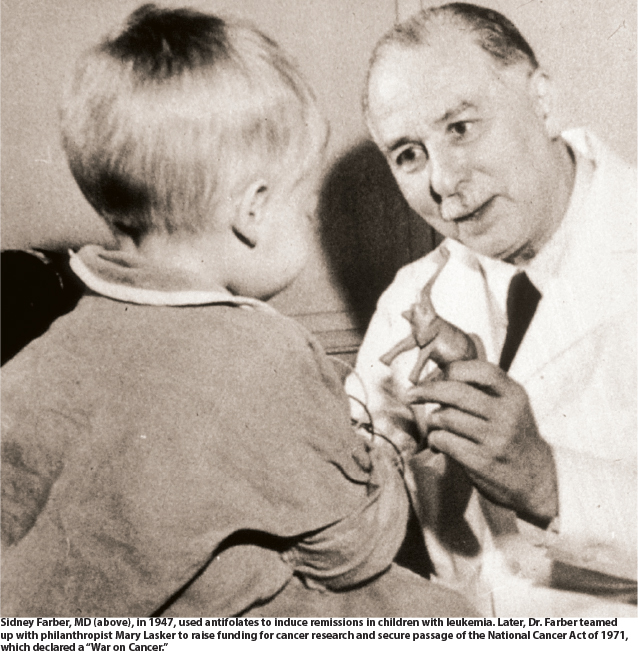Ken Burns Presents Cancer: The Emperor of All Maladies, A Film by Barak Goodman will be broadcast on PBS on March 30, March 31, and April 1. Check local listings for broadcast times.
Like the book it’s based on, the television documentary Ken Burns Presents Cancer: The Emperor of All Maladies, A Film by Barak Goodman chronicles the history of cancer and the devastation it has brought to the lives of countless people, from its first documented appearance over 5,000 years ago to its wide-reaching impact today. Adapted from the Pulitzer Prize–winning book The Emperor of All Maladies: A Biography of Cancer (Scribner, 2010) by Siddhartha Mukherjee, MD, PhD, the film is part historical thriller, part detective mystery, and most of all, a compelling human drama told through the remarkable stories of cancer researchers, patients, and their families.
Pioneering Research
Produced and directed by Barak Goodman in collaboration with Executive Producer and Series Creative Consultant Ken Burns, the film is divided into three 2-hour segments. The first episode of the documentary centers on the pioneering research of Sidney Farber, MD, whose groundbreaking 1948 study of the folic acid antagonist aminopterin as a treatment for children with acute leukemia1 launched the modern era of chemotherapy. Using archival footage of the advocacy efforts of Dr. Farber and philanthropist Mary Lasker to raise funding for cancer research and reduce cancer deaths, the film documents their success in convincing Congress to increase the budget of the National Cancer Institute (NCI) and securing passage of the National Cancer Act of 1971, which declared a “War on Cancer.”
The first part also explores the fits and starts of progress being made in the mid-20th century in the use of combination chemotherapies to treat cancer and in the growing awareness of the causes of the disease, which ushered in a new age in scientific knowledge. The episode features interviews with the most innovative researchers of the time, including Emil J. Freireich, MD, discussing his work with Emil Frei, MD, in the 1950s and 1960s. Their investigations showed that using multiple chemotherapy agents could produce lasting remissions in children with acute lymphoblastic leukemia, among others.
In the second episode, the film moves into advances made over the next 2 decades in the understanding of the genetic basis of cancer and the discovery in the early 1980s by J. Michael Bishop, MD, and Harold Varmus, MD, now Director of the NCI, of the first human oncogene.
‘This Is Our Time’
The final episode showcases the optimism prevalent in cancer research today, as the understanding of what causes cancer on a molecular level continues to grow. That understanding has led to the advent of targeted therapies, which are resulting in durable remissions for some patients with cancer and even turning some cancers into chronic diseases.
“Every field in medicine has had a moment in history that has been transforming—the moment where the knowledge that was required to change the field became available,” José Baselga, MD, PhD, Physician-in-Chief and Chief Medical Officer at Memorial Sloan Kettering Cancer Center, New York, tells viewers in the introduction to the film. “And my prediction is that the next 20 years [will be] the age of discovery for cancer and the age for new therapies. This is our time.”
Challenges of Adapting the Book to Film
According to the film’s director Barak Goodman, more than 100 people were interviewed and nearly 700 hours of film produced over the course of 2 years, which then had to be whittled down to just 6 hours for the final production. While most of the documentary was filmed at The Sidney Kimmel Comprehensive Cancer Center at Johns Hopkins Medicine in Baltimore and Charleston Area Medical Center in West Virginia, ASCO’s 2013 Annual Meeting in Chicago served as one of the film’s locations, where many of the experts appearing in the film were interviewed.
Mr. Goodman, whose documentaries include Scottsboro: An American Tragedy and Clinton, said making Cancer: The Emperor of All Maladies presented unique difficulties. “Artistically and aesthetically, making this film was enormously challenging. I don’t think there has ever been a film project that has attempted to weave a historical narrative with a verité contemporary film and a science film together in this way,” said Mr. Goodman. “I think this film is utterly unique in that way. It was also extremely emotionally challenging because we got very, very close to the patients we filmed, some of whom didn’t survive their cancer.”
Among those connected with the film who did not survive their disease was the actor Edward Herrmann, who narrates the film. He died of glioblastoma a few weeks after completing his work on the documentary.
Making the Story Accessible
Telling a story about a subject as complex—and frightening—as cancer, and making it understandable and accessible to a large general audience, also posed challenges for Mr. Goodman.
“The only way viewers could fully understand the science in episode 3, which details the exciting developments happening in cancer research today, was by having a primer on what cancer is—and in the first two episodes, that is what they get. The science is embedded in the historical narrative, so without even knowing it, viewers are learning the basics of what cancer is before they get to the more detailed science in the last episode,” explained Mr. Goodman.
While the stories chronicling the setbacks and advances in cancer research over the past 8 decades give the film its scientific soul, it is the contemporary stories of patients undergoing therapy that give it heart.
“I hope that people aren’t scared away by the subject,” said Mr. Goodman. “I think the audience will be fascinated by this film and will want to watch it and see how the stories of the patients turn out. Ultimately, this is a very hopeful film and one that will make people feel better about cancer … and about what would happen today if they or their loved ones were diagnosed with the disease. We are entering a new day, and things are looking up. People shouldn’t be terrified to watch the program and see how treatments are improving in cancer.” ■
Reference
1. Farber S, Diamond LK: Temporary remissions in acute leukemia in children produced by folic acid antagonist, 4-aminopteroyl-glutamic acid. N Engl J Med 238:787-793, 1948.







